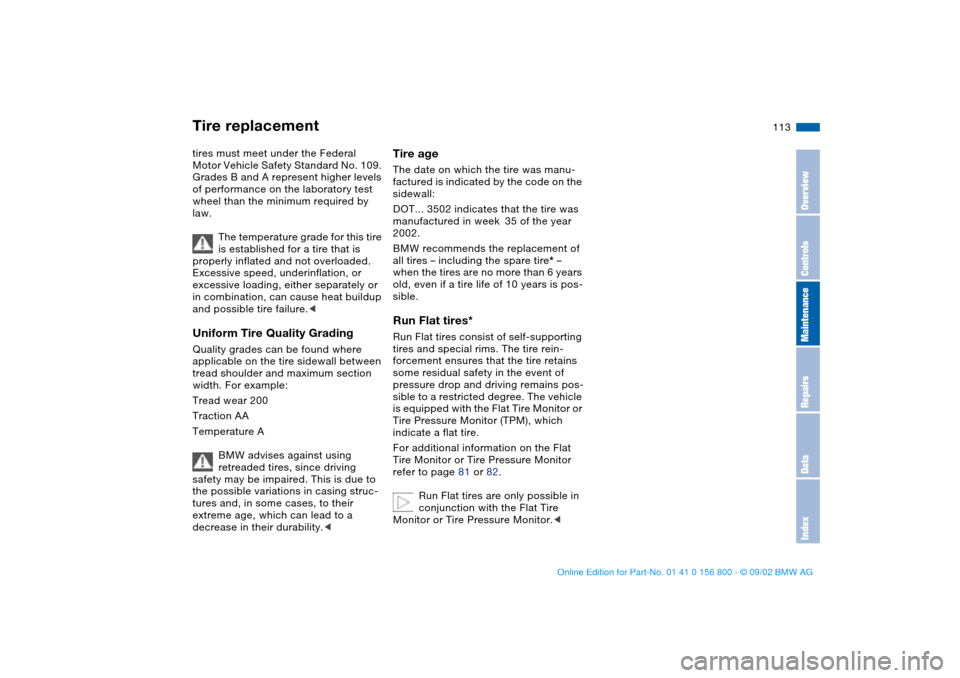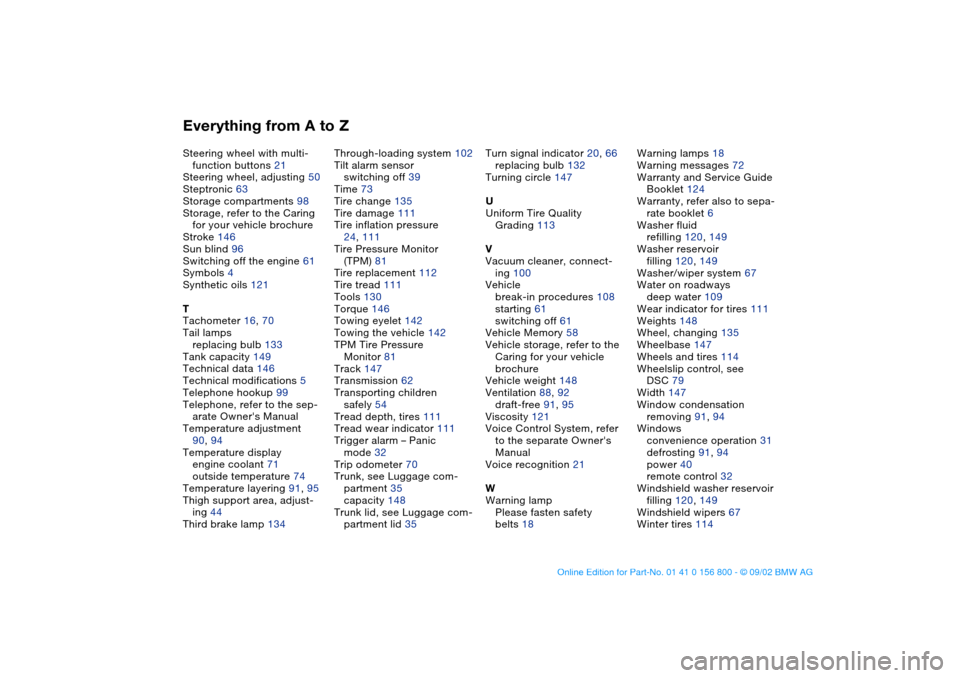2003 BMW 325Ci COUPE run flat
[x] Cancel search: run flatPage 10 of 162

Contents
Operation, maintenance
Special operating instructions:
Break-in procedures108
Driving notes109
Antilock Brake System
(ABS)109
Brake system110
Wheels and tires:
Tire inflation pressure111
Tire condition111
Tire replacement112
Wheel and tire
combinations114
Winter tires114
In the engine compartment:
Hood116
Engine compartment
essentials118
Washer fluids120
Engine oil120
Coolant122
Brake fluid123
Maintenance:
The BMW Maintenance
System124
Laws and regulations:
California Proposition 65
warning126
OBD interface socket126
Owner service procedures
Replacement procedures:
Onboard tool kit130
Windshield wiper blades130
Lamps and bulbs131
Changing a wheel135
Run Flat tires*139
Battery140
Fuses140
Giving and receiving
assistance:
Jump-starting141
Towing the vehicle142
Technical data
Engine data146
Dimensions147
Weights148
Capacities149
handbook.book Page 10 Tuesday, July 30, 2002 12:16 PM
Page 113 of 162

113
tires must meet under the Federal
Motor Vehicle Safety Standard No. 109.
Grades B and A represent higher levels
of performance on the laboratory test
wheel than the minimum required by
law.
The temperature grade for this tire
is established for a tire that is
properly inflated and not overloaded.
Excessive speed, underinflation, or
excessive loading, either separately or
in combination, can cause heat buildup
and possible tire failure.
tread shoulder and maximum section
width. For example:
Tread wear 200
Traction AA
Temperature A
BMW advises against using
retreaded tires, since driving
safety may be impaired. This is due to
the possible variations in casing struc-
tures and, in some cases, to their
extreme age, which can lead to a
decrease in their durability.<
Tire ageThe date on which the tire was manu-
factured is indicated by the code on the
sidewall:
DOT... 3502 indicates that the tire was
manufactured in week 35 of the year
2002.
BMW recommends the replacement of
all tires – including the spare tire* –
when the tires are no more than 6 years
old, even if a tire life of 10 years is pos-
sible.Run Flat tires*Run Flat tires consist of self-supporting
tires and special rims. The tire rein-
forcement ensures that the tire retains
some residual safety in the event of
pressure drop and driving remains pos-
sible to a restricted degree. The vehicle
is equipped with the Flat Tire Monitor or
Tire Pressure Monitor (TPM), which
indicate a flat tire.
For additional information on the Flat
Tire Monitor or Tire Pressure Monitor
refer to page 81 or 82.
Run Flat tires are only possible in
conjunction with the Flat Tire
Monitor or Tire Pressure Monitor.<
Tire replacement
OverviewControlsMaintenanceRepairsDataIndex
handbook.book Page 113 Tuesday, July 30, 2002 12:16 PM
Page 139 of 162

139
Run Flat tires*Run Flat tires are labeled on the side-
wall with a circular symbol containing
the letters RSC. Run Flat tires consist of
self-supporting tires and special rims.
The tire reinforcement ensures that the
tire retains some residual safety in the
event of pressure drop and driving
remains possible to a restricted degree.
The vehicle is equipped with the Flat
Tire Monitor or Tire Pressure Monitor
(TPM), which indicate a flat tire.
Because the sides of Run Flat
tires are reinforced, a drop in infla-
tion pressure usually cannot be
detected from the outside.<
Flat tireIf there is a tire failure, the red warning
lamp symbol lights up. This visual alert
is accompanied by an acoustic warning
signal.
Additional information on the Tire Pres-
sure Monitor or Flat Tire Monitor is
found beginning on page 81.
Reduce vehicle speed carefully to
under 50 mph / 80 km/h, avoiding hard
brake applications and steering maneu-
vers.
If it can not be determined immediately
from the outside which wheel is defec-
tive, check the tire inflation pressure at
all four wheels.
Have Run Flat tires replaced by
your BMW center. In the interest
of safety, Run Flat tires should not be
repaired. Your BMW center has the
information needed for working with
Run Flat tires and is equipped with the
necessary special tools.<
If appropriate, please consult your
BMW center to reequip your vehi-
cle from summer to winter tires – or vice
versa.<
Driving with a damaged tireRun Flat tires allow you to continue
driving to a restricted degree at a maxi-
mum speed of 50 mph / 80 km/h
depending on the cargo load and the
extent of tire damage. You can deter-
mine the distance you may continue
driving on the basis of the following val-
ues:
>Tire inflation pressure of 0 psi/
0 kilopascal (kPa):
approx. 100 miles/150 km
>Tire inflation pressure of approx.
7-15 psi/50-100 kPa:
approx. 300 miles/500 km
>Tire inflation pressure greater than
15 psi/100 kPa:
approx. 600 miles/1,000 km.
Drive cautiously. Do not exceed a
speed of 50 mph / 80 km/h. Be
aware that vehicle handling will be
altered when there is a loss in inflation
pressure. Anticipate, e.g., reduced
tracking during braking, longer braking
distances and changed steering char-
acteristics.<
OverviewControlsMaintenanceRepairsDataIndex
handbook.book Page 139 Tuesday, July 30, 2002 12:16 PM
Page 155 of 162

Everything from A to Z
155
N
Navigation System, refer to
the separate Owner's
Manual
Neckrest 46
O
OBD interface socket 126
Obstruction protection 40
Odometer 70
Oil
capacity 149
quality 121
viscosity 121
Oil additives 121
Oil change intervals, refer to
the Service and Warranty
Information Booklet for US
models/Warranty and Ser-
vice Guide Booklet for
Canadian models
Oil consumption 120
Oil dipstick 120
Oil filter change 149
Oil level
checking 120
indicator lamp 18
Oil pressure
indicator lamp 18
OIL SERVICE 72
Oil types 121Onboard computer, refer to
the Owner's Manual for
Onboard Computer
Onboard tool kit 130
Operating elements 14
Outlets, ventilation 88, 92
Outside temperature dis-
play 74
P
Panic mode – trigger
alarm 32
Park Distance Control
(PDC) 76
Parking aid 76
Parking brake 61
Parking lamps 85
replacing bulb 132
PDC Park Distance
Control 76
Pocket flashlight 98
Pollen 91, 96
Power output 146
Power seat 45
Pressure, tires 24, 81, 111
monitoring 81
R
Radiator 149
Radio
refer to the Owner's Man-
ual for RadioRain sensor 67
Range 75
Reading lamps
front 87
rear 87
Rear backrest, folding 102
Rear center 3-point safety
belt 102
Rear lamps 133
Rear window defroster
90, 95
Rearview mirror 50
Recirculated-air mode
90, 95
Reclining seat 43
Refueling 23
Remote control 31
Remote control keys 30
Replacement key 30
Reporting safety defects 6
Reserve indicator lamp 71
Reverse 62
Roof load capacity 148
Roof-mounted luggage
rack 105
Run Flat tires 113, 139
S
Safe seating position 43
Safety belt height adjust-
ment 47
Safety feature 40Seat adjustment 43
mechanical 44
power 45
Seat heating 49
Seat memory 48
Securing cargo 105
Securing devices 105
Selector lever, automatic
transmission 63
Service and Warranty Infor-
mation Booklet 124
Service interval display
72, 124
Shiftlock 63
Side airbags 52
Size 147
Ski bag 103
Sliding/tilt sunroof 41
closing following an elec-
trical malfunction 42
convenience operation 31
remote control 32
Snow chains 115
Socket 100
Spare key 30
Spare tire 135
Speedometer 16
Sports seat 44
Standing lamps 86
Starting problems 59
Starting the engine 59
Steering wheel lock 59
OverviewControlsMaintenanceRepairsDataIndex
handbook.book Page 155 Tuesday, July 30, 2002 12:16 PM
Page 156 of 162

Everything from A to ZSteering wheel with multi-
function buttons 21
Steering wheel, adjusting 50
Steptronic 63
Storage compartments 98
Storage, refer to the Caring
for your vehicle brochure
Stroke 146
Sun blind 96
Switching off the engine 61
Symbols 4
Synthetic oils 121
T
Tachometer 16, 70
Tail lamps
replacing bulb 133
Tank capacity 149
Technical data 146
Technical modifications 5
Telephone hookup 99
Telephone, refer to the sep-
arate Owner's Manual
Temperature adjustment
90, 94
Temperature display
engine coolant 71
outside temperature 74
Temperature layering 91, 95
Thigh support area, adjust-
ing 44
Third brake lamp 134Through-loading system 102
Tilt alarm sensor
switching off 39
Time 73
Tire change 135
Tire damage 111
Tire inflation pressure
24, 111
Tire Pressure Monitor
(TPM) 81
Tire replacement 112
Tire tread 111
Tools 130
Torque 146
Towing eyelet 142
Towing the vehicle 142
TPM Tire Pressure
Monitor 81
Track 147
Transmission 62
Transporting children
safely 54
Tread depth, tires 111
Tread wear indicator 111
Trigger alarm – Panic
mode 32
Trip odometer 70
Trunk, see Luggage com-
partment 35
capacity 148
Trunk lid, see Luggage com-
partment lid 35Turn signal indicator 20, 66
replacing bulb 132
Turning circle 147
U
Uniform Tire Quality
Grading 113
V
Vacuum cleaner, connect-
ing 100
Vehicle
break-in procedures 108
starting 61
switching off 61
Vehicle Memory 58
Vehicle storage, refer to the
Caring for your vehicle
brochure
Vehicle weight 148
Ventilation 88, 92
draft-free 91, 95
Viscosity 121
Voice Control System, refer
to the separate Owner's
Manual
Voice recognition 21
W
Warning lamp
Please fasten safety
belts 18Warning lamps 18
Warning messages 72
Warranty and Service Guide
Booklet 124
Warranty, refer also to sepa-
rate booklet 6
Washer fluid
refilling 120, 149
Washer reservoir
filling 120, 149
Washer/wiper system 67
Water on roadways
deep water 109
Wear indicator for tires 111
Weights 148
Wheel, changing 135
Wheelbase 147
Wheels and tires 114
Wheelslip control, see
DSC 79
Width 147
Window condensation
removing 91, 94
Windows
convenience operation 31
defrosting 91, 94
power 40
remote control 32
Windshield washer reservoir
filling 120, 149
Windshield wipers 67
Winter tires 114
handbook.book Page 156 Tuesday, July 30, 2002 12:16 PM